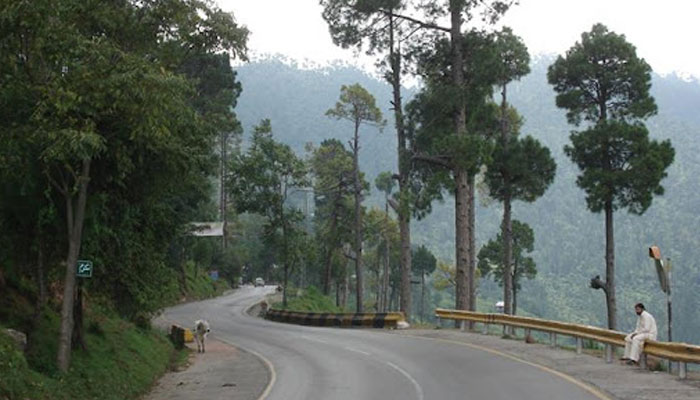PM’s strict action to avert human, environmental catastrophe in Murree
ISLAMABAD: Following the intervention of the prime minister to save Murree from a possible human and environmental catastrophe, the Punjab government has issued new building bylaws for construction to put an immediate end to the mushroom growth of concrete structures in the most popular hill station of the country.
Known as the Queen of the Hills, Murree is seriously threatened by huge concrete structures and multi-storeyed buildings. On the direction of Prime Minister Imran Khan, the Punjab government issued on Oct 9, 2021, building bylaws under which only ground plus two with a maximum height of 38 feet will be allowed, as the area falls in a seismically active zone.
Sources say that the Commissioner Rawalpindi will also lead the operation to check the construction of unauthorized buildings including those which are or have been built in violation of the building bylaws.
Notified by the municipal committees of Murree, Kahuta and Kotli Sattian, all the concerned officials and authorities have been directed to strictly implement these bylaws and put an immediate halt to the high-rise concrete structures fast emerging on hills falling in a seismically active zone.
The bylaws, the sources said, will also focus on the protection and preservation of the wildlife, natural beauty, habitats, forests and old trees in the region. This initiative, it is said, reflects the prime minister’s vision for conservation, tourism promotion, wealth creation and wilderness sensitive development.
The sources said the bylaws are an adaption of the building bylaws of the Kaghan Development Authority, which were also made on the direction of Imran Khan. Once similar bylaws are adopted by the Galiyat in Khyber Pakhtunkhwa and possibly by local governments in Azad Jammu & Kashmir, it is expected that the onslaught of concrete frames across this region will be checked, a source said, adding that soon we could see the re-emergence of the iconic wood-based architecture of the Pir-Panjal, Kashmir and Lesser Himalayas.
The revival of wood as a construction material is expected to lead to a business model for faster carbon-sequestration entailing commercial forestry in the permissible zones. As per the bylaws, prior approval from the municipal committee shall be required to build or alter any infrastructure along with the submission of plans, necessary documentation, and certification. The construction seeking party will be liable to involve only professionals from their respective areas of expertise during each process. The plan approval committee will be constituted by the municipal committee to supervise all this.
These bylaws urge builders to establish mandatory open spaces on all sides of buildings (front, rear, sides). All the buildings must contain a ramp for differently abled people, proper ventilation, windows, doors (as described in the bylaws), exits and passages in case of an emergency. These bylaws also take into account the Pakistan Environmental Policy Act 1997 to cover the infrastructure used in buildings like chimneys, antenna towers, air conditioning and other ducts. Buildings must contain an effective garbage disposal and sewerage system to avoid the littering of public places.
The bylaws also cover the parking aspect for not only locals but also for tourists. Adequate parking space must be provided in every commercial/residential building as per their use evaluated by the plan approval committee to cater to the parking constraints for everyone.
The bylaws also require the builder to display proper warning signs outside the premises of a construction site. Water supply is a huge problem in tehsil Murree. The bylaws introduce a sustainable provision to solve the problem by making rainwater harvesting structures compulsory in houses larger than five marlas.
For the preservation of existing plantations, trees will only be allowed to be cut down after the approval of the municipal committee, but the building plan will be approved subject to the plantation of trees. Removal of one tree must be compensated by planting five to ten new trees, whereas trees older than 20 years would not be allowed to be cut down. During the construction of infrastructure like roads, rail networks and bridges, wildlife crossings, that will allow wildlife to cross man-made barriers, will be made compulsory.
-
 Why Isn't King Charles Mourning Death Of His Father's First Cousin?
Why Isn't King Charles Mourning Death Of His Father's First Cousin? -
 Nicole Richie Breaks Silence On Her Daughter's Name Change
Nicole Richie Breaks Silence On Her Daughter's Name Change -
 Truth Behind Chris Noth, Sarah Jessica Parker's Ongoing Feud Revealed
Truth Behind Chris Noth, Sarah Jessica Parker's Ongoing Feud Revealed -
 Baseless Gender Identity Rumors Targeted At Bettijo Hirschi After Todd Bridges Split
Baseless Gender Identity Rumors Targeted At Bettijo Hirschi After Todd Bridges Split -
 'Harry Potter' TV Series Roped In Hans Zimmer For Score
'Harry Potter' TV Series Roped In Hans Zimmer For Score -
 Amy Robach, T.J. Holmes Make Daring Invite To Exes Marilee, Andrew
Amy Robach, T.J. Holmes Make Daring Invite To Exes Marilee, Andrew -
 Louis Tomlinson Gushes Over Harry Styles' Talent
Louis Tomlinson Gushes Over Harry Styles' Talent -
 Brian Austin Green Says THIS Relationship Left Him Feeling 'not Good Enough'
Brian Austin Green Says THIS Relationship Left Him Feeling 'not Good Enough' -
 Amy Robach, T.J. Holmes Shun Former Friends At 'GMA'?
Amy Robach, T.J. Holmes Shun Former Friends At 'GMA'? -
 Timothée Chalamet Shares Nervous Experience From 'Marty Supreme'
Timothée Chalamet Shares Nervous Experience From 'Marty Supreme' -
 'Andrew Leaving One Mansion To Go To Another Mansion'
'Andrew Leaving One Mansion To Go To Another Mansion' -
 Spotify Introduces New Monthly Subscription Pricing Plan For 2026
Spotify Introduces New Monthly Subscription Pricing Plan For 2026 -
 Shocking Prediction About Meghan Markle's Career In 2026
Shocking Prediction About Meghan Markle's Career In 2026 -
 Kate Middleton Hosts Reception In London As Prince William Out On Engagement
Kate Middleton Hosts Reception In London As Prince William Out On Engagement -
 Mel C Teases 'precious' Future Plans
Mel C Teases 'precious' Future Plans -
 Teyana Taylor On Julia Roberts Telling Her To 'eat A Sandwich' At Golden Globes: 'Started Crying'
Teyana Taylor On Julia Roberts Telling Her To 'eat A Sandwich' At Golden Globes: 'Started Crying'




